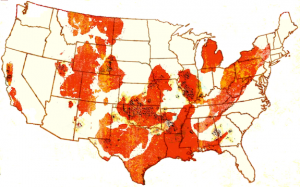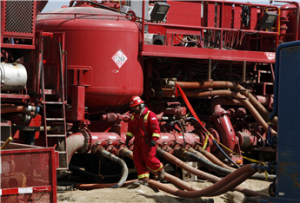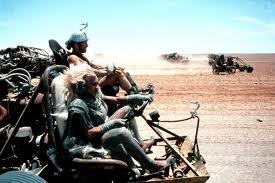 Mr. Grizzly, Mr. Deliverance and Mr. Biscuit – Contractors and the Eagle Ford Labor Market
Mr. Grizzly, Mr. Deliverance and Mr. Biscuit – Contractors and the Eagle Ford Labor Market
Among the main lessons of our tour of the Eagle Ford, is that there’s a lot of jobs down here. If you’re a man currently out of work, and you have the use of all of your limbs, there’s a job available for you in South Texas, right now. Like, today. If you feel like working for a living – go.
At the newly constructed drilling pad the first order of business was to receive another safety briefing. If I – in my hazmat suit – look like I just escaped from the movie set of E.T., our safety instructor looks like he escaped from the movie set of Deliverance. He of the scraggly goatee points out the safe gathering point on the pad in the event of a massive blowout or fire. He makes me nervous on a number of different fronts.
Another grizzled veteran – with 40 years of drilling experience – takes over the drilling pad narrative at this point.
While Mr. Grizzly is old enough to be a grandfather, this is not your grandfather’s drilling operation. He explains that this particular drill rig we’re looking at, built a few days before we arrived, can ‘walk.’ What he means is they can drill 10,000 feet underground for a few days, then slide the entire 100 foot above-ground structure a few feet away and drill an entirely new underground well, without dismantling the rig.
Since the relevant underground piping for hydrocarbon is horizontal, underground wells can line up next to each other a few feet away but cover a horizontal mile in entirely different directions from a single drilling pad. This ability to ‘walk’ the rig and set up multidirectional horizontal wells saves days of labor and hundreds of thousands of dollars.
Mr. Grizzy loves this feature.
Listening to Mr. Grizzly I’m struck that this place isn’t swarming with younger guys, and Mr. Grizzy tells us why. When the 1980s oil crash struck Texas, an entire generation of workers washed out of the business to work elsewhere. A few like Mr. Grizzly and Mr. Deliverance stuck it out, and new guys are now joining up, but there’s a missing generation of workers, adding to the difficulty of finding competent experienced workers in the Eagle Ford shale.
Also notable on the drill site are the predominance of contractors.
Everything, it turns out, seemingly depends on contractors and sub-contractors. Halliburton is on the drilling pad here, as is Schlumberger, to name two huge world-wide oil-service contractors.[1] But everything down to skilled mechanics and plumbers has to be located and hired separately.[2]
This makes sense as I think about this now, since so much is needed in this previously-empty outback country. Hardly anybody lived out here before the Eagle Ford shale play began, so everything has to be provided in the absence of pre-existing infrastructure. Contractors guard the gates to the drilling site; contractors supply the tricked-out Mad Max trucks; contractors even set up the barbecue tent where we were served lunch.
Our host company owns the lease, will oversee extraction from the site for years to come, and will take the oil and gas to market once it gets above ground, but they’ve sub-contracted the actual few weeks of drilling to another group, and that’s who Mr. Deliverance works for. Mr. Deliverance’s team sets up the drill rig in less than a week and spends another week drilling up to ten thousand feet underground and as much as a mile horizontally, blasting and fracking as it goes. Following an intense 2-3 weeks of drilling activity, the drilling contractor moves to the next drill site with the same or a different independent operator.
With some sense of what we’re now looking at, we are invited to climb aboard the actual rig, where our steel-toed boots come in handy. We clamber up steep steps to a platform, then over a series of porous metal grates. Underfoot we see specialty ‘mud’ stored beneath us, a chemically-treated liquid mixture to facilitate the upcoming drilling process. The actual chemicals mentioned were a mystery to me, but Mr. Grizzly mentions falling into the ‘mud’ container at least once in the past. Mr. Grizzly appears well past procreation age to me, so I’ve decided not to worry about that too much.[3]
Later in the day, at a separate fracking site, I get another taste of the tight labor market down here. In an air-conditioned trailer, two men watch flat-screen monitors where all manner of data keeps them apprised of ongoing fracking activity on site.
One of the men hardly notices us, so engrossed is he in his monitors, but the other introduces himself cheerfully as a native of Biscuit, KY. Based on his overall affect, not to mention his denim overalls, if he wasn’t overseeing a fracking job I’m pretty sure he’d be watching professional wrestling on his couch, right now. He seemed pretty happy, indeed surprised, to be gainfully employed. Somehow his provenance from Biscuit tells me what I need to know about the labor market in the Eagle Ford shale. And no, I can’t find Biscuit, KY on Google Maps either.
See also Part I – Mad Max Bizarro World
Part II – Big, Corporate, Well Capitalized
Part III – The Drilling and Fracking Scene
Part IV – How Big Is This?
[1] One of the unfortunately named contractors on this site was Patterson-UTI. My wife’s an infectious disease doctor, and as such, would never endorse naming something “UTI.” It sounds like something you’re likely to catch from the infamous ‘Man Camps’ that have sprung up around fracking areas around the country.
[2] I asked our hosts towards the end of the day how someone could ‘get rich’ in Eagle Ford right now. They all agreed setting up a contracting company was the way to go. Anyone with a skill and a willingness to work hard could make a good living with so much need for skilled labor.
[3] On the other hand, the unique combination of chemicals in the ‘mud,’ if they didn’t kill him, might have been enough to make him unbelievably strong. Isn’t that how most superheroes get made? Can somebody do a cartoon mockup for me of Mr. Grizzly and his superpowers after he emerges from the ‘mud?’
Post read (4861) times.




